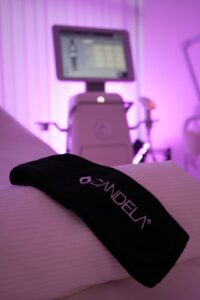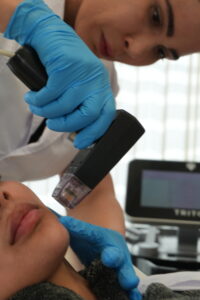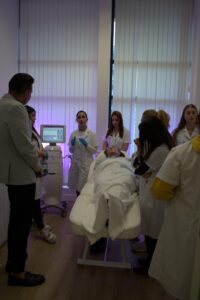Optimizing Microneedling Radiofrequency: Understanding Mechanism, Impedance, and Customization for Better Results
Faramarz Rafie M.D./ Vancoderm Academy (VDA) / Vancoderm Clinic (VDCmed.com)
Microneedling radiofrequency is a rapidly growing treatment in advanced medical aesthetics. It combines the benefits of traditional Microneedling with targeted radiofrequency energy to stimulate collagen production, improve skin texture, and enhance firmness. For optimal results, it is essential to understand how Microneedling RF works and how to adjust treatment settings based on anatomical location, skin hydration, penetration depth, and real-time impedance.

What is Microneedling Radiofrequency
Microneedling RF is a dual-action therapy. Fine microneedles penetrate the skin to create micro-injuries. At the same time, radiofrequency energy is delivered into the dermis and sometimes deeper layers. This process creates thermal stimulation in the tissue, promoting natural collagen and elastin remodeling. The treatment is widely used for skin rejuvenation, scar revision, and skin tightening on the face and body.
Mechanism of Action: How RF Energy Interacts with Tissue
Radiofrequency energy generates heat through tissue resistance. The key factor here is the amount of resistance, also known as impedance. As RF travels through the skin, areas with higher water content conduct the energy better, resulting in more controlled and efficient heating. The microneedles act as conduits, delivering RF energy directly into specific skin layers for targeted tissue remodeling.
Understanding Impedance and Conductivity
Impedance is the resistance that tissue presents to the flow of electrical current. It varies by tissue type, hydration level, and skin condition. Lower impedance allows better energy delivery. Higher impedance reduces energy penetration and may lead to insufficient results or discomfort.
- Lower impedance is often found in hydrated, vascular tissues such as the dermis.
- Higher impedance is seen in dry, fatty, or scarred tissue.
- Extremely high or low impedance may indicate poor contact or inappropriate energy settings.
Monitoring impedance during treatment helps providers adjust energy levels in real-time to improve outcomes and safety.

Impedance Differences by Tissue Layer
- Epidermis: moderate impedance, serves as a protective barrier
- Dermis: low impedance, rich in water and collagen, primary target for RF
- Hypodermis: higher impedance due to fat content, absorbs less energy
Adjusting Treatment Based on Anatomic Site and Skin Condition
Different areas of the body require different approaches due to variation in skin thickness, hydration, and underlying structure.
Anatomic Site
- Forehead and around the eyes: thinner skin, requires shallow needle depth and lower energy.
- Cheeks, jawline, and neck: moderate to thick skin, can tolerate deeper penetration and moderate to higher energy.
- Abdomen, thighs, and body: thicker dermis and subcutaneous tissue, typically require deeper penetration and higher energy
*There is a justified caution in treating the jawline with Microneedling RF, especially in darker skin types or with improper settings. However, when proper technique, device settings, and needle choice are applied, this area can still be safely treated.
Penetration Depth
- Shallow depths target the upper dermis and are suitable for fine lines and general skin rejuvenation
- Medium depths reach the mid-dermis and are effective for acne scars, texture issues, and moderate laxity
- Deep settings target subdermal layers and are useful for body tightening or deeper scars, but may show higher impedance due to fat tissue
Electrode and Needle Type
- Monopolar RF delivers deeper energy and is often used for body treatments
- Bipolar or multipolar RF is more localized and safer for the face
- Insulated microneedles focus RF energy at the needle tip, protecting the epidermis
- Non-insulated microneedles deliver energy along the full shaft, suitable for deeper or more aggressive treatments

Skin Hydration and Dryness
- Dry or dehydrated skin presents higher impedance and poor conductivity, leading to uneven heating
- Well-hydrated skin allows smoother energy delivery and more consistent results
Improving skin hydration before treatment is essential. This may include applying conductive gels or hydrating serums, avoiding alcohol-based cleansers before the session, and ensuring clients are adequately hydrated.
How Impedance Affects RF Energy Delivery
Low Impedance
- Good hydration
- Conductive tissue
- Allows smoother energy flow
- Ideal for consistent collagen remodeling
High Impedance
- Dry, fatty, or scarred tissue
- Can resist RF energy
- May require parameter adjustment
- May reduce clinical effectiveness
Recommended Adjustments Based on Treatment Area
| Area | Needle Depth | Energy Level | Needle Type | Tip |
| Forehead | 0.5–1.0 mm | Low | Insulated | Thin skin; avoid overheating |
| Cheeks | 1.5–2.5 mm | Moderate | Insulated or Non-Insulated | Good for rejuvenation |
| Jawline/Neck | 2.0–3.0 mm | Moderate to High | Insulated preferred | Avoid thyroid zone |
| Abdomen | 2.5–4.0 mm | Higher | Monopolar or Non-Insulated | Check impedance continuously |
Insulated vs. Non-Insulated Microneedling RF Needles
| Feature | Insulated Needles | Non-Insulated Needles |
| Structure | RF energy is delivered only at the needle tip | RF energy is delivered along the entire needle shaft |
| Heat Distribution | Localized to deep dermis | Affects epidermis, dermis, and upper subdermal layers |
| Epidermal Protection | High – minimal surface damage | Low – higher risk of post-inflammatory pigmentation |
| Ideal Use | General skin rejuvenation, superficial treatments | Deep acne scars, thick skin, or deep tissue tightening |
| Risk Level | Lower (especially for darker skin tones) | Higher – requires more skill and caution |
| Pain and Downtime | Typically less painful, shorter downtime | Can be more painful with longer recovery |

When to Choose Which
- Insulated Needles:
- Safer for darker skin types (Fitzpatrick IV to VI)
- Used near sensitive areas like under the eyes or forehead
- Ideal for general rejuvenation, texture, and fine lines
- Non-Insulated Needles:
- More effective for deep acne scars, stretch marks, or severe skin laxity
- Should only be used by trained providers due to higher risk of surface damage
- Better for thick or photodamaged skin
Optimizing Microneedling RF Treatment
Skin Anatomy and RF Target Zones
| Skin Layer | Description | Targeted with RF? | Impedance Level |
| Epidermis | Outer protective layer | Partially (insulated needles skip this) | Moderate |
| Dermis | Contains collagen, elastin, blood vessels | Yes – Primary target for collagen induction | Low |
| Hypodermis | Fat and connective tissue | Sometimes (body tightening) | High |
How to Adjust Parameters Based on Impedance Readings
- If impedance is high, reduce needle depth slightly or increase energy cautiously, and assess skin hydration
- If impedance is low, reduce energy to prevent overheating or excessive thermal injury
- Use real-time impedance monitoring to guide safe and effective settings throughout the session
IF YOU SEE HIGH IMPEDANCE, what should you do?
In most cases, you should reduce the depth.
Higher Impedance Often Means:
- You’re not in a high-water-content area (like dermis).
- You’re too shallow (in the dry, resistant epidermis), OR
- You’re too deep (in fibrotic or fatty hypodermis where resistance increases again).
Ideal impedance range is typically in the dermis.
- The dermis has more water content, which lowers impedance and improves energy conduction.
Treatment Tips for Better Results
- Customize settings based on skin thickness, hydration level, and treatment goals
- Use insulated needles for superficial treatments or sensitive areas
- Use non-insulated needles for deep acne scars or thicker tissue
- Apply conductive or hydrating serums to improve RF penetration
- Reassess impedance continuously and adjust energy levels as needed
Thank you for being part of this journey with Vancoderm Academy. We’re proud to share knowledge that empowers professionals and elevates the standards of medical aesthetics.
To stay up to date with the latest innovations, expert insights, and upcoming training opportunities, follow us on our official channels and join our growing community of passionate practitioners.
Together, let’s shape the future of Medical Aesthetics.
Thank you!

